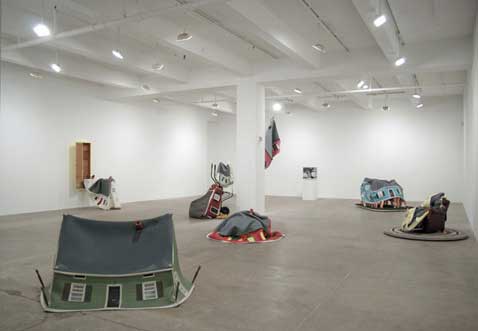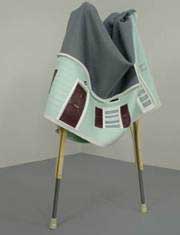|
Dwell › Blogs
March 9, 2009
Living in Levittown
By - Miyoko Ohtake
One of the criticisms of suburbia is its homogeneity—and there's no better
example of monotonous development than the Levittown communities built in the
1940s, 50s, and 60s. The history books credit the four highly planned towns
for defining suburbia as we know it today. Artist Brian Tolle's current
exhibit in New York City uses Levittown as an example of society's
simultaneous embrace and rejection of mass consumerism.

One of the criticisms of suburbia is its homogeneity—and there's no better
example of monotonous development than the Levittown communities built in the
1940s, 50s, and 60s. The history books credit the four highly planned towns
for defining suburbia as we know it today. Artist Brian Tolle's current
exhibit in New York City uses Levittown as an example of society's
simultaneous embrace and rejection of mass consumerism.
During World War II, Abraham Levitt and his sons, who had earlier established
Levitt and Sons construction company, perfected their prefab techniques
through a Navy commission to build homes for shipyard workers in Norfolk,
Virginia. In the post-war boom, Levitt and Sons set their sights larger and
announced a 2,000-rental home community on Long Island, built specifically
for veterans. Before long an additional 4,000 homes were added to accommodate
the demand—and with them, schools, a post office, and the other necessities
for a growing town. By the end of the 40s, Levitt and Sons began building
homes for permanent residency and Levittown, New York
became one of the first American suburbs and a symbol of post-war life.
Levitt and Sons followed up with similarly designed communities in
Pennsylvania, New Jersey, and Puerto Rico.

Today you can drive through the Levittowns or,
through March 21, visit the CRG Gallery
in New York City for a more critical look at the designs. Artist Brian
Tolle's "Levittown" installation features silicon molds of the New
York Levittown homes draped over everyday objects that reflect American
mass-production, such as a shopping cart, hair dryer, and basketball hoop. As
the exhibition text describes, the rubber skins—all cast from the same
mold—and the objects they cover highlight the dueling responses
"specific to American consumerism: the seduction toward conformity or
compliance with a mass-produced standard and the necessity to define one's
identity through the alteration or defiance of it."

I have a personal, albeit slightly second-hand, connection to the Levitt
and Sons communities: My mother spent a good deal of her childhood as a
resident of the Levitt and Sons-design community in New Jersey, known then as
Levittown, New Jersey,
but now as Willingboro. As my interest in architecture became more and more
evident during my youth, my mother (correctly) thought that I'd enjoy hearing
about this town where she grew up.
She gave me a basic briefing on the layout and guiding principles, but what I
took away was this: In the New Jersey community, the different sections of
Levittown had different names, and the street names in each section began
with the same letter as the section name. So, if you lived in Millbrook Park,
you might have lived on Middlebury or Manor lanes.

Growing up is difficult enough for any kid, and even more so when your
name is Patricia Palmer, which makes your initials "P.P." Now
imagine being this Patricia Palmer (whose brothers and sister included Pete,
Paul, and Pam) are living in at 25 Patriot Lane in Pennypacker
Park. I'm sure it helped my mother develop a thick skin, and for me, it's
created a soft, if not humor-driven, spot in my heart for the Levittowns.
If you're in New York City, I recommend stopping by the CRG Gallery before
the Brian Tolle show closes on March 21. The gallery is located at 535 West
22nd St. and open Tuesday through Saturday from 10 am until 6 pm. For more information,
visit crggallery.com.
|



